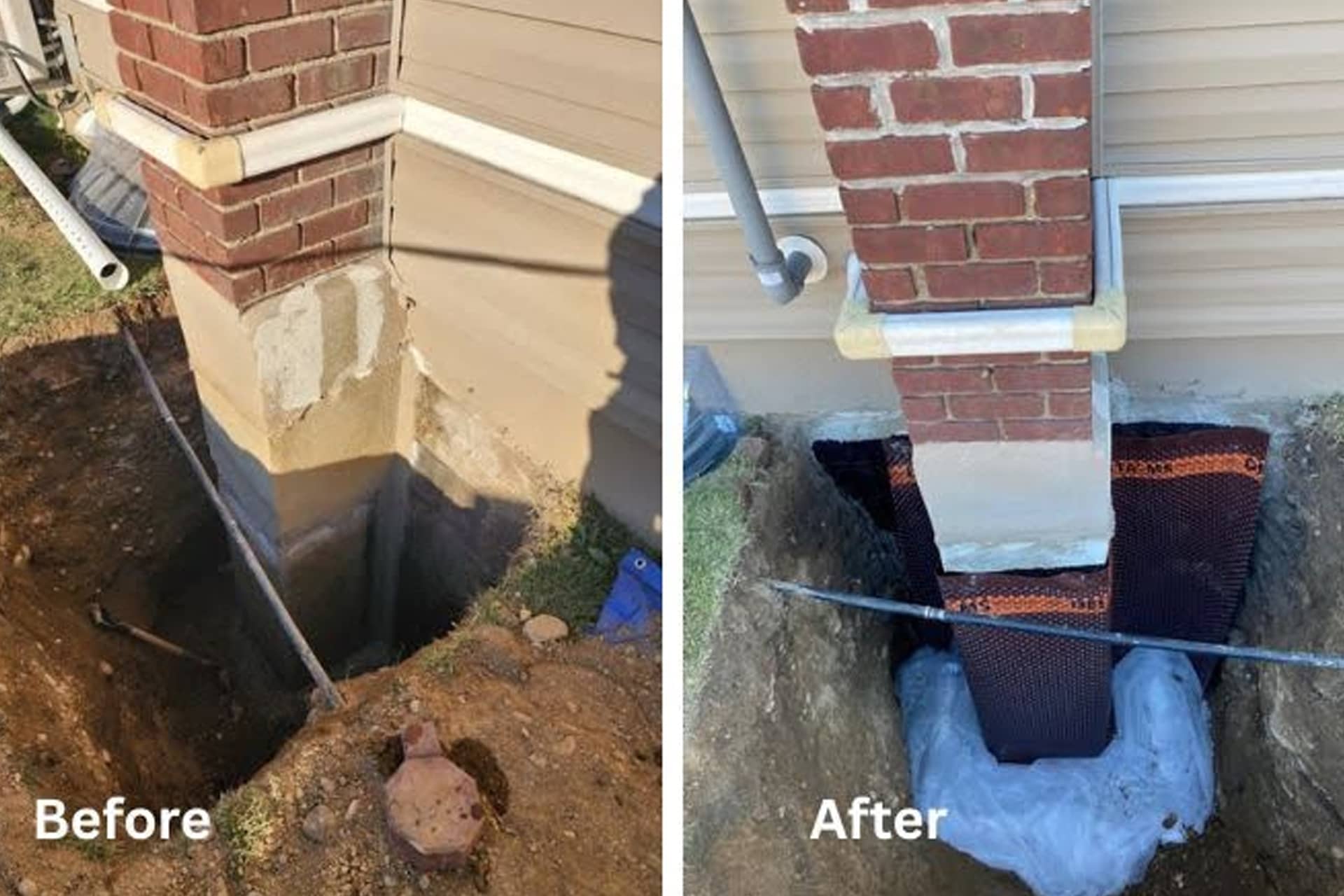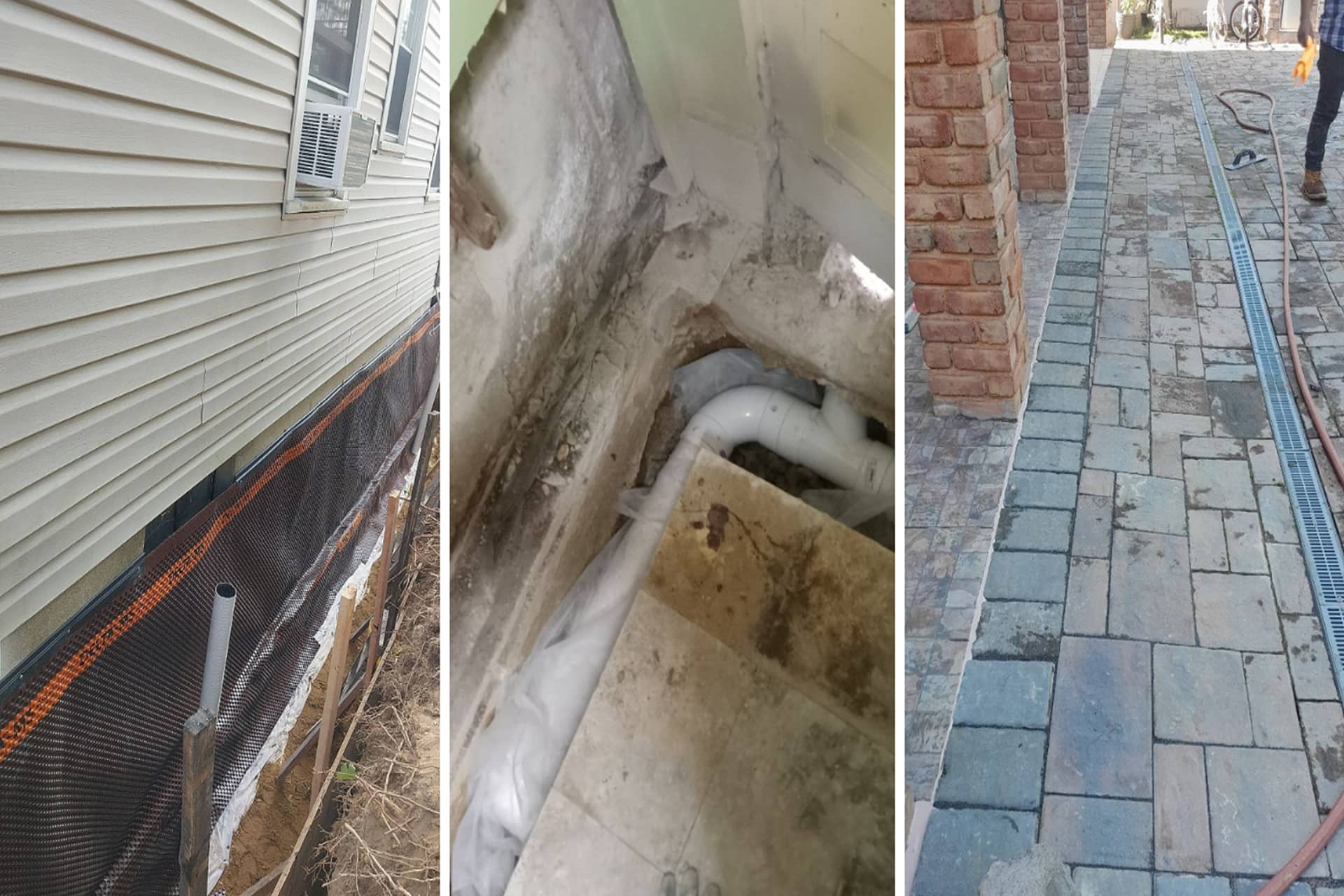If your foundation sits below ground, it’s constantly under attack by rain, rising groundwater, and the unseen pressure that builds up in the soil around your home. This is called hydrostatic pressure, and left unchecked, it can force water through concrete walls, crack foundations, and flood basements from the inside out.
Below-grade waterproofing is how you stop it. It’s the system of membranes, coatings, and drainage solutions that protect the parts of your property you can’t see but rely on every day: your foundation, basement, and crawl space.
At Zavza Seal, we specialize in below-grade waterproofing, foundation repair, and structural protection across Long Island and New York City, using proven methods that meet ASTM standards and local building codes. Whether you’re a homeowner tired of damp walls or a contractor seeking reliable below-grade specifications for new construction, our team designs custom solutions that keep structures dry for decades, not seasons.
Don’t Wait for the Next Storm to Test Your Foundation. Request a Free Below-Grade Waterproofing Inspection!

What Is Below-Grade Waterproofing?
Below-grade waterproofing is the process of protecting building foundations and walls located below ground level from water intrusion, soil moisture, and hydrostatic pressure. It involves installing waterproof membranes, drainage systems, and protective coatings that form a continuous barrier between the surrounding soil and the building envelope.
In simple terms, “below grade” means anything built beneath the soil line, such as basements, crawl spaces, and underground garages. These hidden spaces are most vulnerable to leaks because they sit in constant contact with wet soil, especially after storms or snowmelt.
Think of it this way: if it’s under dirt, it needs defense.
A proper system includes:
- Waterproofing membrane applied to the exterior wall
- Footing drain or French drain to divert groundwater away
- Protective barrier or drainage board to relieve pressure against the wall
Need Your Basement Evaluated for Hidden Leaks? Request a Free Below-Grade Waterproofing Inspection!
Benefits of Below-Grade Waterproofing
Below-grade waterproofing safeguards your home’s structure, air quality, and long-term value. Here’s why investing in a professional system pays off:
- Prevents Costly Structural Damage: Keeps hydrostatic pressure and soil moisture from cracking or weakening foundation walls and slabs.
- Stops Mold and Mildew Growth: Eliminates the damp conditions that lead to poor indoor air quality and health concerns.
- Protects Your Home’s Value: A dry basement enhances resale appeal and reassures buyers that your property is well maintained.
- Improves Energy Efficiency: Dry foundations retain heat better, reducing humidity and lowering heating and cooling costs.
- Extends the Life of Finishes and Flooring: Prevents warping, bubbling, or peeling in finished basements and crawl spaces.
- Reduces Insurance and Maintenance Costs: Many insurers reward proactive waterproofing with lower premiums and fewer future claims.
Protect Your Home Before the Next Heavy Rain. Get a Free Below-Grade Waterproofing Estimate Today!

Case Study: Exterior Foundation Waterproofing in Sayville, NY
A homeowner in Sayville, NY faced persistent water intrusion in their finished subgrade room, threatening both comfort and structural integrity. The moisture was damaging drywall, flooring, and foundation walls, creating a long-term risk of mold and settlement. Zavza Seal, a trusted Long Island waterproofing contractor, was called in to deliver a lasting solution.
The Problem
Water was entering through the exterior foundation wall, increasing hydrostatic pressure and causing visible moisture damage. Without intervention, the problem could have led to serious structural deterioration and mold growth.
The Solution
Our team performed a full excavation along 32 linear feet of the foundation, repairing cracks and applying a reinforced waterproofing system. We sealed the wall-footing joint with fiber mesh and waterproof cement, applied a liquid rubber membrane, and installed a Delta dimpled waterproofing barrier with a 4-inch perforated drainage pipe to redirect water away from the structure.
Result: The subgrade room remains dry and structurally sound, giving the homeowner lasting protection and peace of mind.
Why Below-Grade Areas Are at the Highest Risk
The ground around your home is never dry for long. Rainwater, melting snow, and fluctuating groundwater levels constantly saturate the soil, and that moisture puts relentless pressure on below-grade walls.
This pressure is known as hydrostatic pressure; the force exerted by standing water against a surface. Over time, it pushes moisture through tiny cracks, joints, and pores in the concrete, even if the wall looks solid. (For a deeper explanation, see our Hydrodynamic Pressure Guide.)
Once water finds its way in, several problems follow:
- Flooded basements after nor’easters or heavy rainfall
- Cracks in foundation slabs from uneven soil pressure
- Mold or efflorescence forming behind finished walls
- Peeling coatings or damp corners that signal rising capillary moisture
Below-grade areas face this risk every day because water doesn’t need an open gap to enter. Just time and pressure. Without a proper waterproofing system, even hairline cracks can allow gallons of water to seep through each day.
Common Signs of Below-Grade Water Problems
If you notice any of the following warning signs, your foundation may already be letting water in:
- Damp or musty odor
- Efflorescence (white mineral deposits) on walls
- Peeling paint or bubbling foundation coatings
- Mold growth in lower corners
- Standing water or seepage at the wall-floor joint
Did You Know?
Even tiny hairline cracks can let in gallons of water each day under pressure.
Schedule a Free Inspection and We’ll Identify Seepage Sources Before They Cause Damage!

Below-Grade Waterproofing Methods
Below-grade waterproofing methods protect your foundation by stopping water at its source or managing it once it enters. Depending on your property and soil conditions, professionals may recommend exterior, interior, or integrated systems.
Each method works together to keep basements dry, prevent structural damage, and extend the life of your home. Choosing the right system ensures long-term protection and peace of mind.
Here are the most common methods of below-grade waterproofing:
Exterior Waterproofing (Best Long-Term Protection)
This method tackles water at its source, outside your foundation. It involves excavation around the structure, applying waterproofing membranes such as bituminous, elastomeric, or sheet-applied systems, and adding drainage boards with gravel to redirect water flow. A French drain or footing drain completes the system, carrying groundwater safely away from the foundation.
Interior Waterproofing (Fast & Cost-Effective)
Interior systems manage water that has already entered the structure. Solutions include interior drain tiles, sump pumps, vapor barriers, and negative-side waterproof coatings that stop moisture from spreading. This approach is ideal for quick relief from active leaks or dampness without exterior excavation.
Integrated Drainage Design (The Smart Combo)
In areas with high water tables, clay-rich soils, or poor grading, combining interior and exterior systems offers the most reliable protection. This integrated approach stops water before it enters while safely managing any that does, keeping basements dry even in the toughest conditions.
Pro Tip: Exterior systems stop water before it enters. Interior systems manage it after entry. The best designs do both.
Step-by-Step Process: How Professional Waterproofing Works
Every successful waterproofing system starts with precision and ends with peace of mind. Here’s how professionals ensure your below-grade spaces stay dry for decades:
- Site Assessment and Moisture Testing: Specialists evaluate soil type, grading, and water intrusion points using moisture meters and visual inspections.
- Excavation and Wall Cleaning (if exterior): Soil is carefully removed to expose foundation walls, which are cleaned to ensure proper adhesion of coatings or membranes.
- Crack Repair and Sealant Application: Any visible cracks or joints are repaired with hydraulic cement or epoxy injection before waterproofing begins.
- Membrane or Coating Installation: Waterproofing materials—bituminous, elastomeric, or sheet membranes—are applied to form a continuous barrier against moisture.
- Drainage System Integration: A footing or French drain is installed to redirect groundwater away from the foundation, reducing hydrostatic pressure.
- Backfill and Grading Correction: Soil is replaced with proper compaction and slope to direct rainwater away from the home or structure.
- Final Inspection and Quality Assurance: The system is tested and verified to ensure all seams, joints, and connections are watertight.
Cost and ROI for Homeowners
Below-grade waterproofing is an investment that pays for itself many times over, both in protection and property value.
- Average Cost (Long Island Range): $75-$150 per linear foot for exterior systems, $50-$90 per linear foot for interior waterproofing.
- ROI: Prevents over $10,000 in potential structural repairs caused by water damage, mold remediation, and foundation cracking.
- Added Value: Boosts long-term property stability and may qualify for home insurance discounts.
Build It Dry, Build It Strong! Call On Zavza Seal for Expert Below-Grade Waterproofing Contractors in Long Island!
Below-grade waterproofing isn’t just about keeping your basement dry. It’s about protecting the structural core of your home. Moisture damage doesn’t happen overnight, but once it starts, it can weaken concrete, corrode steel reinforcements, and invite costly repairs.
At Zavza Seal, we design and install waterproofing systems that stand up to New York’s toughest conditions, from Long Island’s high water tables to the dense soils of Brooklyn and Queens. Every system we install is built for performance, compliance, and long-term peace of mind.
Protect Your Home From the Ground Up Get a Free Below-Grade Waterproofing Consultation With Zavza Seal!
Frequently Asked Questions About Below-Grade Waterproofing Explained
What does below-grade mean in waterproofing?
It refers to any part of your structure located beneath ground level, including basements, crawl spaces, and foundation walls, that require protection from soil moisture and water pressure.
Is interior or exterior waterproofing better?
Exterior waterproofing offers the most permanent solution by stopping water before it enters. Interior systems are faster and less invasive, making them ideal for managing active leaks or retrofits.
How do I stop basement leaks permanently?
Permanent waterproofing involves sealing cracks, installing a continuous membrane, and integrating proper drainage to redirect groundwater away from the structure.
Can I waterproof below grade from inside?
Yes. Interior systems like vapor barriers, sump pumps, and negative-side coatings can manage water intrusion effectively when exterior excavation isn’t possible.
How much does below-grade waterproofing cost?
On average, homeowners in Long Island and NYC spend $50-$150 per linear foot, depending on system type, soil conditions, and access.What are the best waterproofing materials for foundations?
Sheet membranes and elastomeric coatings are top performers for durability and flexibility, while cementitious coatings and bentonite clay are excellent for specific applications like interior walls or new construction.








